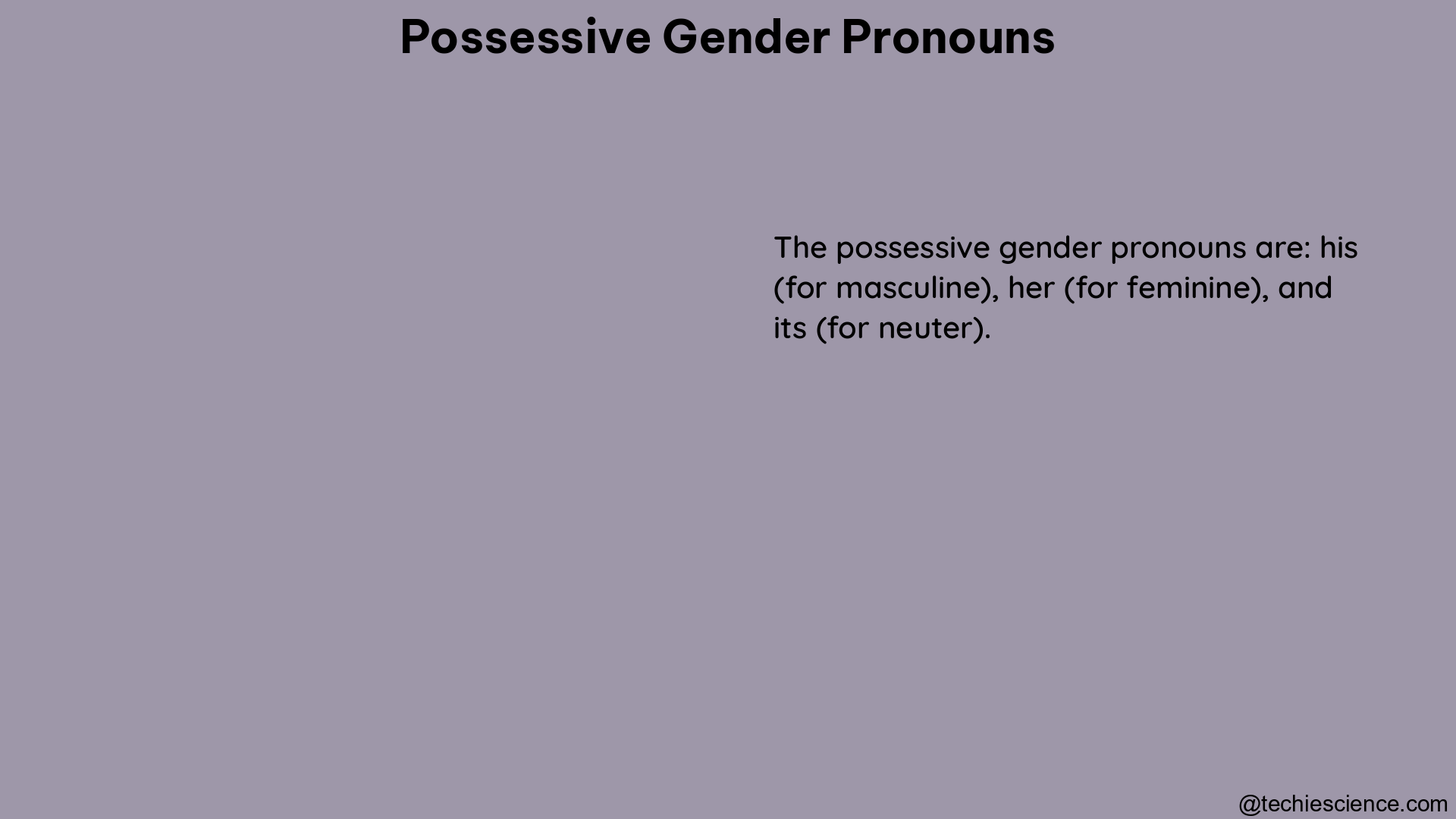Possessive gender pronouns are a crucial aspect of language that help individuals express their gender identity and ensure respectful communication. These pronouns are used to indicate ownership or possession and can vary depending on the individual’s gender identity. In this comprehensive guide, we will delve into the details of possessive gender pronouns, their grammatical specifications, theoretical explanations, and advanced concepts.
Possessive Gender Pronouns: An Overview
Possessive gender pronouns are a set of pronouns that individuals use to express their gender identity and ownership. These pronouns can be categorized into three main groups: traditional binary pronouns, gender-neutral pronouns, and non-binary pronouns.
Traditional Binary Pronouns
The traditional binary pronouns are the most commonly known and used possessive gender pronouns. They are divided into masculine and feminine categories:
- Masculine: He, His
- Feminine: She, Her, Hers
Examples:
– “His book is on the table.”
– “Her car is red.”
Gender-Neutral Pronouns
Gender-neutral pronouns are used by individuals who do not identify with the traditional binary gender categories. These pronouns do not associate a specific gender with the individual. Some common gender-neutral possessive pronouns include:
- They, Them, Theirs
- Xe, Xyr, Xyrs
Examples:
– “Their house is big.”
– “Xyr favorite food is pizza.”
Non-Binary Pronouns
Non-binary pronouns are used by individuals who do not exclusively identify as male or female. These pronouns are often specific to the individual’s gender identity and can include:
- Ze, Hir, Hirs
- E, Em, Eir
- Per, Pers
Examples:
– “Hir favorite color is blue.”
– “Pers favorite sport is soccer.”
Grammatical Specification of Possessive Gender Pronouns

Possessive gender pronouns follow the standard grammatical rules for possessive pronouns in English. They are used to replace nouns in sentences to indicate ownership or possession.
Possessive Pronoun Placement
Possessive gender pronouns are placed before the noun they are modifying, just like other possessive pronouns. For example:
- She: “Her book is on the table.”
- He: “His car is red.”
- They: “Their house is big.”
Possessive Pronoun Declension
Possessive gender pronouns can take different forms depending on their grammatical function in the sentence. The most common forms are:
| Pronoun | Possessive Adjective | Possessive Pronoun |
|---|---|---|
| She | Her | Hers |
| He | His | His |
| They | Their | Theirs |
| Xe | Xyr | Xyrs |
| Ze | Hir | Hirs |
| E | Eir | Eirs |
| Per | Per | Pers |
Examples:
– “This is her book.”
– “The car is his.”
– “That house is theirs.”
Theoretical Explanation of Possessive Gender Pronouns
The use of possessive gender pronouns is rooted in the concept of gender identity and expression. By using the correct possessive pronouns, individuals can assert their gender identity and feel respected and acknowledged. This is particularly important for individuals who do not identify with traditional binary gender categories (male/female) and instead use gender-neutral or non-binary pronouns.
Gender Binary and Its Limitations
The traditional gender binary system only recognizes two genders: male and female. This binary system has been challenged in recent years, as it fails to account for the diverse range of gender identities and expressions that exist.
Gender-Neutral Pronouns and Their Significance
Gender-neutral pronouns, such as “they/them/their,” are used by individuals who do not identify with the traditional binary gender categories. These pronouns help to create a more inclusive and respectful language environment, where individuals can express their gender identity without being limited by the constraints of the gender binary.
Non-Binary Pronouns and Their Importance
Non-binary pronouns, such as “ze/hir/hirs” or “e/em/eir,” are used by individuals who do not exclusively identify as male or female. These pronouns are essential for accurately representing and respecting the diverse range of gender identities that exist beyond the traditional binary.
Advanced Concepts in Possessive Gender Pronouns
As the understanding and acceptance of gender diversity has grown, the landscape of possessive gender pronouns has become more complex and nuanced. Here are some advanced concepts to consider:
Pronoun Neologisms
In addition to the established possessive gender pronouns, some individuals have created new pronoun forms, known as pronoun neologisms. These are often specific to the individual’s gender identity and can include variations on existing pronouns or entirely new pronoun forms.
Pronoun Sharing and Pronoun Etiquette
It is becoming increasingly common for individuals to share their preferred pronouns, either in introductions or in their email signatures or social media profiles. This practice helps to normalize the use of diverse pronouns and promotes a more inclusive environment.
Pronoun Mistakes and Corrections
When using possessive gender pronouns, it is important to be mindful and respectful. If you accidentally use the wrong pronoun, it is important to apologize, correct yourself, and move on without making a big deal out of the mistake.
Conclusion
Possessive gender pronouns are a crucial aspect of language that help individuals express their gender identity and ensure respectful communication. By understanding the different types of possessive gender pronouns, their grammatical specifications, and the theoretical and advanced concepts behind them, we can create a more inclusive and respectful language environment.
Reference:
Hi… I am Sowndharya Jagadeeswaran, a university rank holder in M.A. English Literature. I have also done my master’s in Business Administration. Inquisitive as I am, my interest in action-oriented research helped me publish research papers in reputed journals. Now, as a career, I am an instructor where I teach young and adorable students the intricate technicalities of Public Speaking and Creative Writing. I also enjoy writing articles on topics I specialize and research in.
You can connect with me through LinkedIn.-